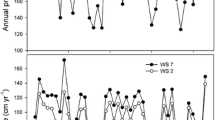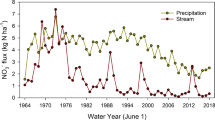Abstract
By synthesizing more than twenty years of research at the Fernow Experimental Forest, we have documented 7 symptoms of nitrogen saturation in two adjacent watersheds. The symptoms include: 1) high relative rates of net nitrification, 2) long-term increases in stream-water concentrations of nitrate and base cations, 3) relatively high nitrate concentrations in solution losses, 4) little seasonal variability in stream-water nitrate concentrations, 5) a high discharge of nitrate from a young aggrading forest, 6) a rapid increase in nitrate loss following fertilization of a young aggrading forest, and 7) low retention of inorganic nitrogen when compared with other forested sites. These data support current conceptual models of nitrogen saturation and provide a strong, and perhaps the best, example of nitrogen saturation in the United States.
Similar content being viewed by others
References
Aber JD (1992) Nitrogen cycling and nitrogen saturation in temperate forest ecosystems. Trends in Ecol Evolut 7: 220–224
Aber JD, Magill A, Boone R, Melillo JM, Steudler P & Bowden R (1993) Plant and soil responses to chronic nitrogen additions at the Harvard Forest, Massachusetts. Ecol Applic 3: 156–166
Aber JD, Nadelhoffer KJ, Steudler P & Melillo JM (1989) Nitrogen saturation in northern forest ecosystems. BioScience 39: 378–386
Adams MB, Edwards PJ, Wood F & Kochenderfer JN (1993) Artificial watershed addifiction on the Fernow Experimental Forest, USA. J Hydrol 150: 505–519
Adams MB, Kochenderfer JN, Wood F, Angradi TR & Edwards P(1994) Forty years of hydrometeorological data from the Fernow Experimental Forest, West Virginia. USDA Forest Service, Northeastern Forest Experimental Station, General Technical Report NE-184, Radnor, Pennsylvania, USA
Ågren GL & Bosatta E (1988) Nitrogen saturation of terrestrial ecosystems. Environ Pollut 54: 185–197
Christ M, Zhang Y, Likens GE & Driscoll CT (1995) Nitrogen retention capacity of a northern hardwood forest soil under ammonium sulfate additions. Ecol Applic 5: 802–812
Corell DL & Weller DE (In press) Nitrogen input-output budgets for forests in the Chesapeake Bay watershed. In: Baker JE (Ed) Atmospheric Deposition of Contaminants to the Great Lakes and Coastal waters. Society of Environmental Toxicology and Chemistry Press, Pensicola Florida, USA
De Boer W, Klein Gunnewiek PJA, Veenhuis M, Bock E & Lannbroek HT (1991) Nitrification at low pH by aggregated chemolithotrophic bacteria. Appl Environ Microbiol 57: 3600–3604
De Boer W, Tietema A, Klein Gunnewiek PJA & Lannbroek HJ (1992) The chemolithotrophic ammonium-oxidizing community in a nitrogen-saturated acid forest soil in relation to pH-dependent nitrifying activity. Soil Biol Biochem 24: 229–234
De Walle DR, Sharpe WE & Edwards PJ (1988) Biogeochemistry of two Appalachian deciduous forest sites in relation to episodic stream addification. Water Air Soil Pollut 40: 143–156
Driscoll CT & Likens GE (1982) Hydrogen ion budget of an aggrading forested ecosystem. Tellus 34: 283–292
Driscoll CT, Schaefer DA, Molot LA & Dillon PJ (1989) Summary of North American data. In: Malanchuk JL & Nilsson J (Eds) The Role of Nitrogen in the Acidification of Soils and Surface Waters (pp 6-1–6-45). Nordic Council of Ministers, København, Denmark
Edwards PJ & Helvey JD (1991) Long-term ionic increases from a central Appalachian forested watershed. J Environ Qual 20: 250–255
Edwards P, Kochenderfer J & Adams M (1992) Effects of repeated ammonium sulfate applications on soil leachate chemistry on the Fernow Experimental Forest in West Virginia, USA. In: Rasmussen L, Brydges T & Mathy P (Eds) Experimental Manipulations of Biota and Biogeochemical Cycling in Ecosystems (pp 122–124) Commission of European Communities, Copenhagen, Denmark
Edwards PJ & Wood F (1993) Field and laboratory quality assurance/quality control protocols and accomplishments for the Fernow Experimental Forest watershed acidification study. USDA Forest Service, Northeastern Forest Experimental Station, General Technical Report N NE-177, Radnor, Pennsylvania, USA
Galloway JN, Levy H & Kasibhatia PS (1994) Year 2020: consequences of population growth and development on deposition of oxidized nitrogen. Ambio 23: 120–123
Galloway JN, Likens GE & Hawley MK (1984) Add precipitation: Natural versus anthropogenic components. Science 226: 829–831
Galloway JN, Schlesinger WH, Levy H, Michaels A & Schnoor JL (1995) Nitrogen fixation: anthropogenic enhancement-environmental response. Global Biogeochem Cycles 9: 235–252
Gilliam FS, Adams MB & Yurish BM (1996) Ecosystem nutrient responses to chronic nitrogen inputs at Fernow Experimental Forest, West Virginia. Can J For Res 26: 196–205
Hauhs M, Rost-Siebert K, Raben G, Paces T & Vigersut B (1989) Summary of European data In: Malanchuk JL & Nilsson J (Eds) The Role of Nitrogen in the Acidification of Soils and Surface Waters (pp 5-1–5-37). Nordic Council of Ministers, København, Denmark
Hedin LO, Armesto JJ & Johnson AH (1995) Patterns of nutrient loss from unpolluted, old-growth temperate forests: Evaluation of biogeochemical theory. Ecology 76: 493–509
Kahl JS, Norton SA, Fernandez IJ, Nadelhoffer KJ, Driscoll CT & Aber JD (1993) Experimental inducement of nitrogen saturation at the watershed scale. Environ Sci & Technol 27: 565–568
Likens GE & Bormann FH (1995) Biogeochemistry of a Forested Ecosystem. Springer-Verlag, New York, New York, USA
Likens GE, Bormann FH, Eaton JS, Pierce RS & Johnson NM (1976) Hydrogen ion input to the Hubbard Brook Experimental Forest, New Hamsphire, during the last decade. Water Air Soil Pollut 6: 435–445
Likens GE, Wright RF, Galloway JN & Butler TJ (1979) Add rain. Sci Am 241: 43–51
Nadelhoffer KJ, Giblin AE, Shaver GR & Linkins AE (1992) Microbial processes and plant nutrient availability in arctic soils. In: Chapin FS, Jefferies RL, Reynolds JF, Shaver GR, Svoboda J & Chu EW (Eds) Arctic Ecosystems in a Changing Climate: An Ecophysiological Perspective (pp 281–300). Academic Press, New York, New York, USA
National Atmospheric Deposition Program (NRSP-3)/National Trends Network (1993) NADP/NTN Cooridation Office, Natural Resource Ecology Laboratory, Colorado State University, Fort Collins, Colorado, USA
Nihlg»rd B (1985) The ammonium hypothesis — an additional explanation to the forest dieback in Europe. Ambio 14: 2–8
Pastor J, Aber JD, McClaugherty CA & Melillo JM (1984) Above ground production and N and P cycling along a nitrogen mineralization gradient on Blackhawk Island, Wisconsin. Ecology 65: 256–268
Schulze E-D (1989) Air pollution and forest decline in a spruce (Picea abies) forest. Science 244: 776–783
Schindler DW, Mills KH, Malley DF, Findlay DL, Shearer JA, Davies IJ, Turner MA, Linsey GA & Cruikshank DR (1985) Long-term ecosystem stress: The effects of years of experimental acidification on a small lake. Science 228: 1395–1401
Statistica (1994) Statistica for Windows: Graphics. StatSoft, Tulsa, Oklahoma, USA
Stoddard JL (1994) Long-term changes in watershed retention of nitrogen: its causes and aquatic consequences. In: Baker LA (Ed) Environmental Chemistry of Lakes and Reservoirs (pp 223–284) American Chemical Society, Washington DC, USA
Stroo HF, Klein TM & Alexander M (1986) Heterotrophic nitrification in an acid forest soil by an acid-tolerant fungus. Appl Environ Microbiol 52: 1107–1111
Tietema A, Riemer L, Verstraten JM, van der Maas MP, van Wijk AJ & van Voorthuyzen I (1993) Nitrogen cycling in acid forest soils subject to increased atmospheric nitrogen input. For Ecol Manage 57: 29–44
Van Breemen N., Burrough PA, Velthorst EJ, van Dobben HF, De Wit T, Ridder TB & Reijnders HFR (1982) Soil acidification from atmospheric ammonium sulphate in forest canopy throughfall. Nature 299: 548–550
Vitousek PM (1977) The regulation of element concentrations in mountain streams in the northeastern United States. Ecol Monogr 47: 65–87
Vitousek PM & Reiners WA (1975) Ecosystem succession and nutrient retention: a hypothesis. BioScience 25: 376–381
Author information
Authors and Affiliations
Rights and permissions
About this article
Cite this article
Peterjohn, W.T., Adams, M.B. & Gilliam, F.S. Symptoms of nitrogen saturation in two central Appalachian hardwood forest ecosystems. Biogeochemistry 35, 507–522 (1996). https://doi.org/10.1007/BF02183038
Received:
Accepted:
Issue Date:
DOI: https://doi.org/10.1007/BF02183038




